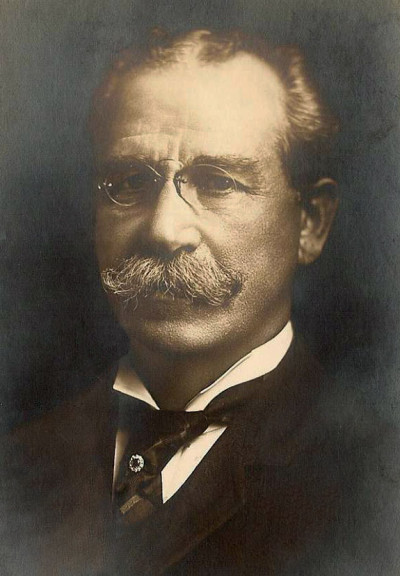John Beggs (John Irvin Beggs)

John Irvin Beggs was born in Philadelphia on September 17, 1847, the son of James and Mary Irvin Beggs. Both of his parents were of Scottish descent but had emigrated to the United States from Northern Ireland. His early life was spent around Philadelphia. After his father died when he was seven years old, Beggs worked to support of his mother in a brickyard, as a cattleman, and butcher. As a young man Beggs taught accounting and handwriting in the Bryant & Stratton Business College in Philadelphia. He went to Harrisburg, Pennsylvania at the age of 21 to work for Mitchell & Haggerty Coal Company as an accountant. He then worked selling real estate and fire insurance in Harrisburg. Beggs joined the Masonic fraternities at Harrisburg and maintained his membership in them until his death.
When the electric light industry was in its infancy, Beggs assisted organization of the Harrisburg Electric Light Co. He built and managed its plant which was “the first commercially successful electric light plant in the United States”. Beggs’ interest in electric lighting arose because he was head of the building committee of Grace Methodist Episcopal Church. He was married in Harrisburg to Sue Elizabeth Charles, who died March 14, 1902. They had one child, Mary Grace Beggs. On account of his success in Harrisburg as an electric plant manager, he was called by J.P. Morgan to New York in 1887 as manager of the Edison Electric Illuminating Co. of that city. He remained in New York for about five years during which time he built the Pearl Street Station and 26th Street Station. Pearl Street provided electricity for the first time to Wall Street’s stockbrokers. He worked closely with Thomas A. Edison and consequently became one of that small group known as Edison Pioneers. Beggs was one of the Illuminating Company Directors at the meeting when Henry Ford first met Edison and presented his idea for the automobile.
From New York he went to Chicago as Western Manager of Edison Company where he remained until the Edison Company was merged with the Thomson-Houston Electric Company to form what is now the General Electric Company. The North American Company, which had just been organized, had acquired an electric lighting interest in Cincinnati, Ohio and Beggs went to Cincinnati in charge of these interests. The North American Company shortly afterward acquired the electric railway and lighting companies in Milwaukee, Wisconsin, and for several years, Beggs divided his time between these cities. In 1897, the Cincinnati interests were sold and Beggs moved to Milwaukee to devote his time to the utilities there.
In 1903, The North American Company began to acquire electric lighting interests in St. Louis, Missouri. Beggs first visited St. Louis as an advisor, and then began to divide his time between the two cities. At one time, Beggs was president of the St. Louis electric lighting company, the gas company, and the street railway company, as well as president and general manager of The Milwaukee Electric Railway and Light Company. While Beggs was President of the Milwaukee Companies he built the Public Service Building in Milwaukee. His funeral services were conducted in its auditorium by the Employees’ Mutual Benefit Association. He also constructed the systems of interurban railways radiating from Milwaukee. By 1911 Beggs had acquired a controlling interest in the St. Louis Car Company. He resigned from the Milwaukee companies and moved to St. Louis. He still maintained many business connections in Milwaukee and spent time there, although his residence was in St. Louis.
In the spring of 1911, Beggs purchased and named Beggs Isle in Lac La Belle, at 43.125°N 88.509°W, near Oconomowoc, Wisconsin. He developed it into a summer residence for himself and his daughter’s family. Beggs turned this island into a botanical garden bringing in exotic plants. Egyptian papyrus plants were trained to last through the long Wisconsin winters. Beggs would purchase large commercial grade fireworks for their Fourth of July celebrations. In 1915, he invested in water power in northern Wisconsin and began to spend more time in that state, although still residing in St. Louis. In 1920 he was again elected president of The Milwaukee Electric Railway and Light Co., which position he still held at the time of his death. Beggs was a member of the Executive Committee of the North American Company. He also devoted much time to the First Wisconsin National Bank in which he invested. During his last decade he directed the construction of the second largest paper mill in the country; engineered the reorganization of the J. I. Case Plow Company, arranged to finance a hotel in Atlantic City, New Jersey. and conducted a large Florida real estate transaction. He died in Milwaukee on October 17, 1925 at the age of 78. He was buried in Harrisburg, Pennsylvania.
Born
- September, 17, 1847
- USA
- Philadelphia, Pennsylvania
Died
- October, 17, 1925
- USA
- Milwaukee, Wisconsin
Cemetery
- Harrisburg, Pennsylvania
- USA

